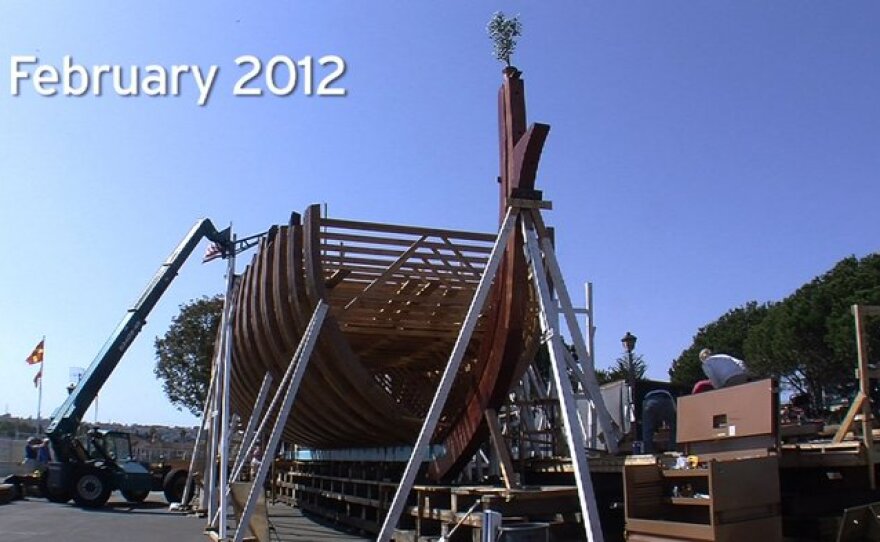Two years in the making, the replica of a 16th century Spanish galleon is taking form at a work site near Lindbergh Field. The ship was supposed to be launched by year's end, but construction is about only 80 percent complete.

On a recent day, an excited group gathered aboard the deck of the unfinished San Salvador, eager to hear how the progress was coming. They learned construction — done almost entirely by volunteers — was running about a year behind schedule.
But Maritime Museum president Ray Ashley said delays actually had been good for the project and community.
“As a consequence, more schools have come to visit the ship while it's being built, more people have come to see it while it's being built, and we've had an opportunity for more volunteers to work on it,” Ashley said.
Construction began at Spanish Landing Park back in February 2011, on what will eventually be a 200-ton, historically accurate replica of the first ship to land on San Diego's shores.
In 1542, explorer Juan Rodriguez Cabrillo sailed the original San Salvador into what is now San Diego Bay, and claimed it for Spain. Now, volunteers and Maritime Museum employees are building this replica by hand and almost entirely from wood -- 230,000 pounds of it.
They hope to launch next summer and they're inviting some special guests to the christening.
“We'd love the king and queen of Spain to come, and as soon as we have a firm date, we'll let them know,” said Dave MacVean, chair of the Maritime Museum’s board.
Despite construction delays, the project is within its estimated $6.2 million budget, thanks to donated materials and volunteer manpower. But that project still needs about $1 million in funding. The hope is that special behind-the-scene tours will draw more volunteers and capital.
Volunteer coordinator Eric Gerhardt said his workforce grew from 300 in February to nearly 500 volunteers Monday.
“I think it's the spirit of the San Salvador, the ship. How many people in the world have the opportunity to work on a Spanish galleon?” Gerhardt said. “And people that have wood-working as their nature, this is certainly the largest wood-working project you can probably find in the entire world.”
Volunteers are also installing the mechanical innards of the ship, like modern-day engines, which will be hidden from view to keep the ship looking as it did in 1542. The rigging is being built, planking is being placed on the frame. The 60-foot masts — cut from one huge Douglas fir — also just arrived.

The ship eventually will serve as a floating classroom. Children will sail on it nearly every day, taking ocean samples and doing meteorological experiments along the way.
"We want school kids to know about our maritime heritage,” MacVean said.
“Most of us came to the United States or California on a boat one way or another. And so for a kid who maybe plays video games a lot of times, or he's watching TV, to get aboard a ship like this — and to really sail it, to pull a line, to adjust a sail, to feel a 100-foot ship move through the water — is something that can really affect them for the rest of their lives," he said.
For now, the shipyard is open every day between 11 a.m. and 4 p.m., for the public to watch the construction, or even take part in it.






